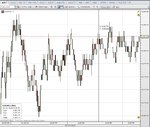Interesting idea. Not enough info. For the benefit of the members, they may need to know when and how results will be announced. If you have info on how this will play out, please share.
Found this, 382 counting areas whose results will be collated by 12 regions. It will be the regions that declare and the approximate times of declaration are listed.
The Electoral Commission are providing data to broadcasters to help them provide information on voting totals throughout the night, including local and regional totals once they have been announced.
The Commission will not have a live results feed on their website. Broadcasters running live count event programmes and newswires have been given access to a feed of data from the referendum result collation system that the Electoral Commission will be using, so will be able to get information in real-time throughout the night.
Please note that local and regional totals will only be sent to broadcasters on the data feed once the Electoral Commission receive confirmation they have been announced locally, which means there will be a slight delay between local / regional declarations and the information broadcasters / newswires receive from the Electoral Commission . Local authorities will also publish results on their respective websites once Counting Officers have declared their local result and the Electoral Commission are encouraging everyone to use #EURefResults when tweeting totals.
The traders trading this way will have lists of predicted pole results for each of the 382 local authorities. And the trading decisions will be based on the differences from the prediction to the actual results.
For the average chap though, it may be easier to trade on the 12 government local area results.
I think the most important decision is what to trade. Trading sterling on the results just seems crazy to me. The volatility will be nuts and the banks have set themselves up with so many disclaimers for tomorrow that they can basically do what they want. Fill, don't fill, gap don't gap. They basically have the ability to do what the h*ll they want to ensure payback time for getting smacked by the SNB.
I think a safer trade would be to trade the flight to safety. JPY, Swissy or even gold on the night if it's an exit and probably abstain if it's the more likely stay in result.
If you are unsure in any way then STAY AWAY FROM THE MARKETS until next week.
With wild swings YOU COULD LOOSE EVERYTHING. IG are currently on a 6% margin on sterling. For cable you would need £890 for every £1 you wish to trade. (at the time of this post.)
Last edited:

